Report: Dynamics of Leadership in U Care Organization
VerifiedAdded on 2019/12/03
|19
|5125
|149
Report
AI Summary
This report examines the dynamics of leadership within the U Care organization, a national charity with regional managers overseeing staff and volunteers. It explores the role and process of leadership, emphasizing the importance of employee motivation and efficient delegation. The report delves into the power and influence of leadership, considering cultural, ethical, and gender-related challenges, alongside the significance of training and time management. It presents leadership models, including Hill's leadership model, and discusses various motivational theories such as Maslow's and Herzberg's, and cognitive theories. The report also covers team development, organizational change, and different leadership styles, providing a comprehensive overview of effective leadership practices. The report concludes with a synthesis of the key findings and recommendations for fostering successful leadership within the organization.
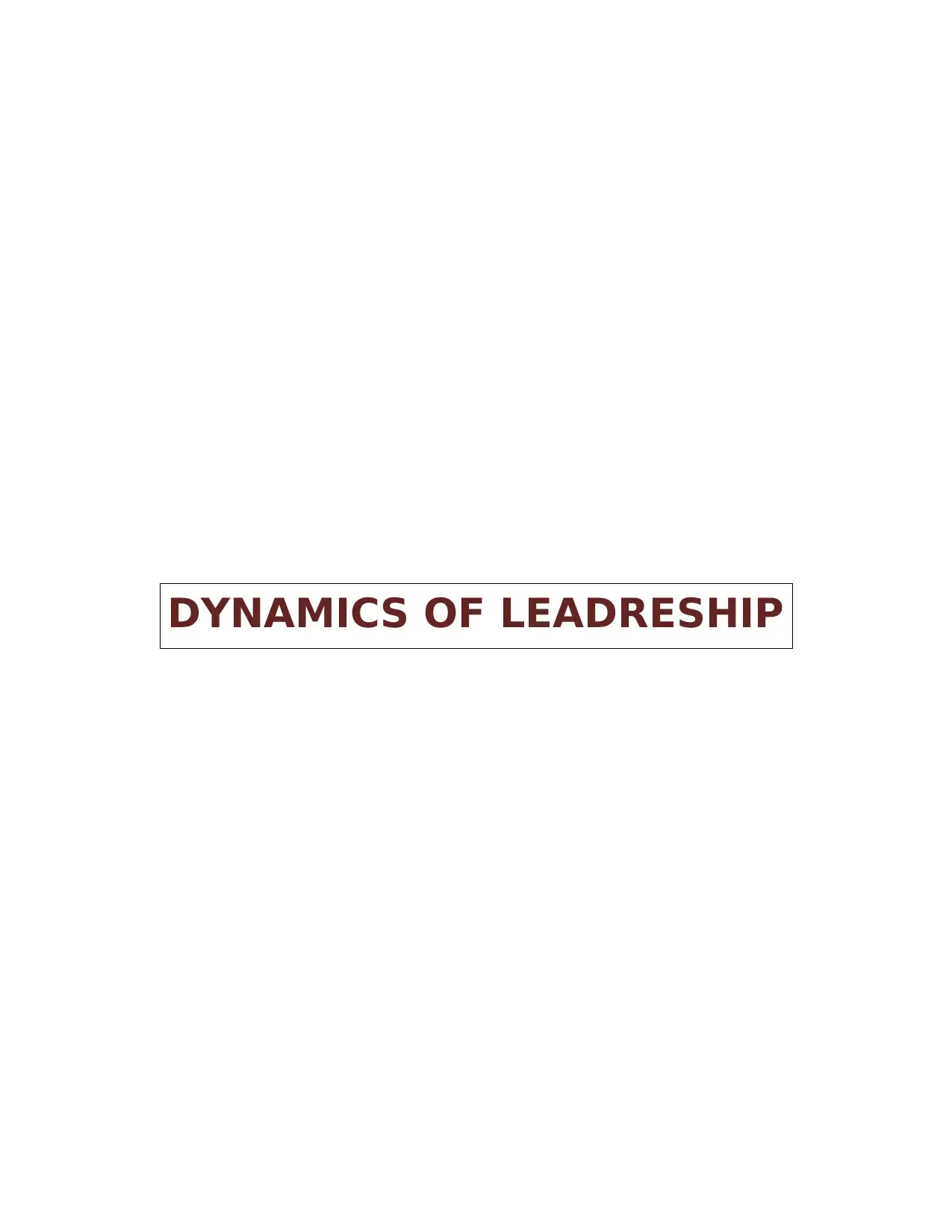
DYNAMICS OF LEADRESHIP
Paraphrase This Document
Need a fresh take? Get an instant paraphrase of this document with our AI Paraphraser
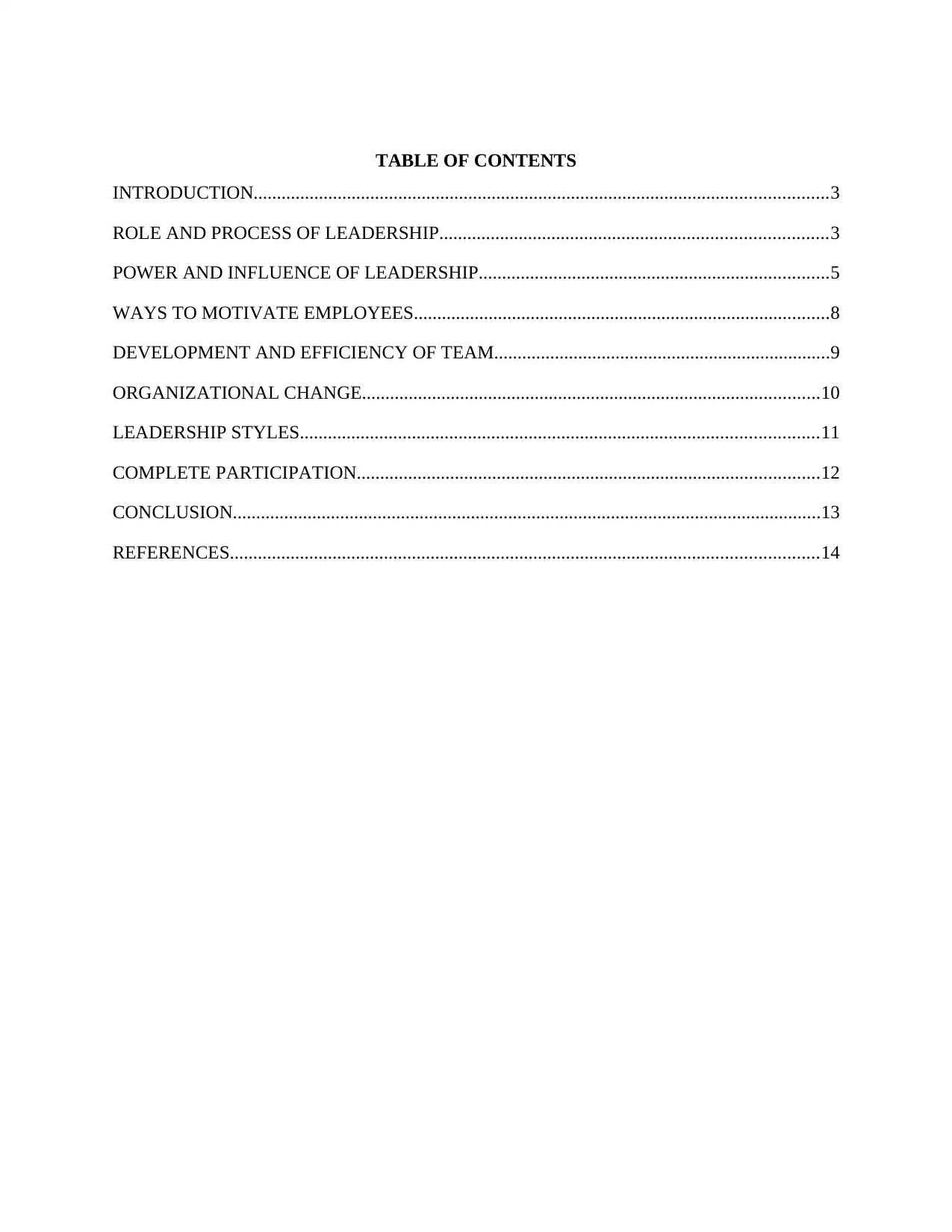
TABLE OF CONTENTS
INTRODUCTION...........................................................................................................................3
ROLE AND PROCESS OF LEADERSHIP...................................................................................3
POWER AND INFLUENCE OF LEADERSHIP...........................................................................5
WAYS TO MOTIVATE EMPLOYEES.........................................................................................8
DEVELOPMENT AND EFFICIENCY OF TEAM........................................................................9
ORGANIZATIONAL CHANGE..................................................................................................10
LEADERSHIP STYLES...............................................................................................................11
COMPLETE PARTICIPATION...................................................................................................12
CONCLUSION..............................................................................................................................13
REFERENCES..............................................................................................................................14
INTRODUCTION...........................................................................................................................3
ROLE AND PROCESS OF LEADERSHIP...................................................................................3
POWER AND INFLUENCE OF LEADERSHIP...........................................................................5
WAYS TO MOTIVATE EMPLOYEES.........................................................................................8
DEVELOPMENT AND EFFICIENCY OF TEAM........................................................................9
ORGANIZATIONAL CHANGE..................................................................................................10
LEADERSHIP STYLES...............................................................................................................11
COMPLETE PARTICIPATION...................................................................................................12
CONCLUSION..............................................................................................................................13
REFERENCES..............................................................................................................................14
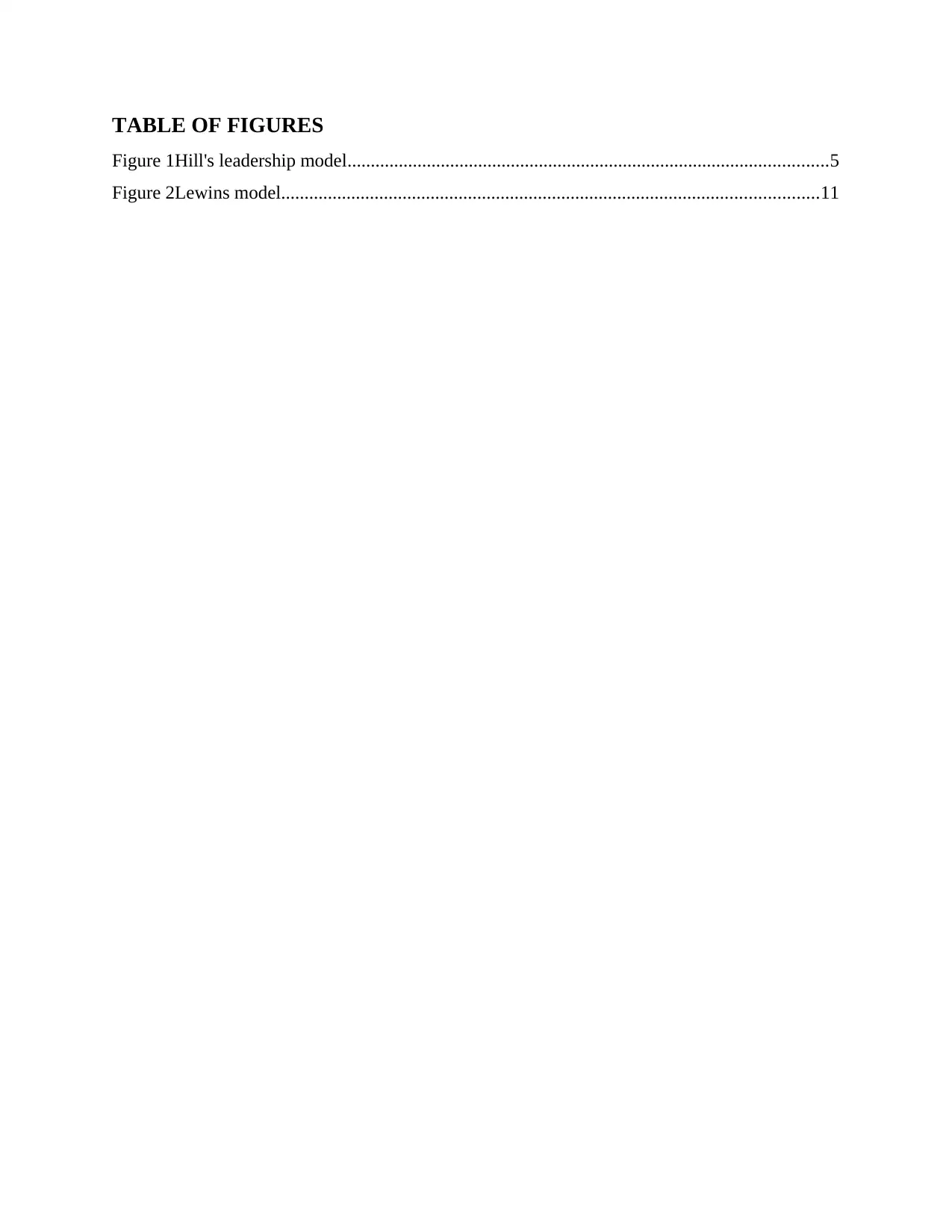
TABLE OF FIGURES
Figure 1Hill's leadership model.......................................................................................................5
Figure 2Lewins model...................................................................................................................11
Figure 1Hill's leadership model.......................................................................................................5
Figure 2Lewins model...................................................................................................................11
⊘ This is a preview!⊘
Do you want full access?
Subscribe today to unlock all pages.

Trusted by 1+ million students worldwide
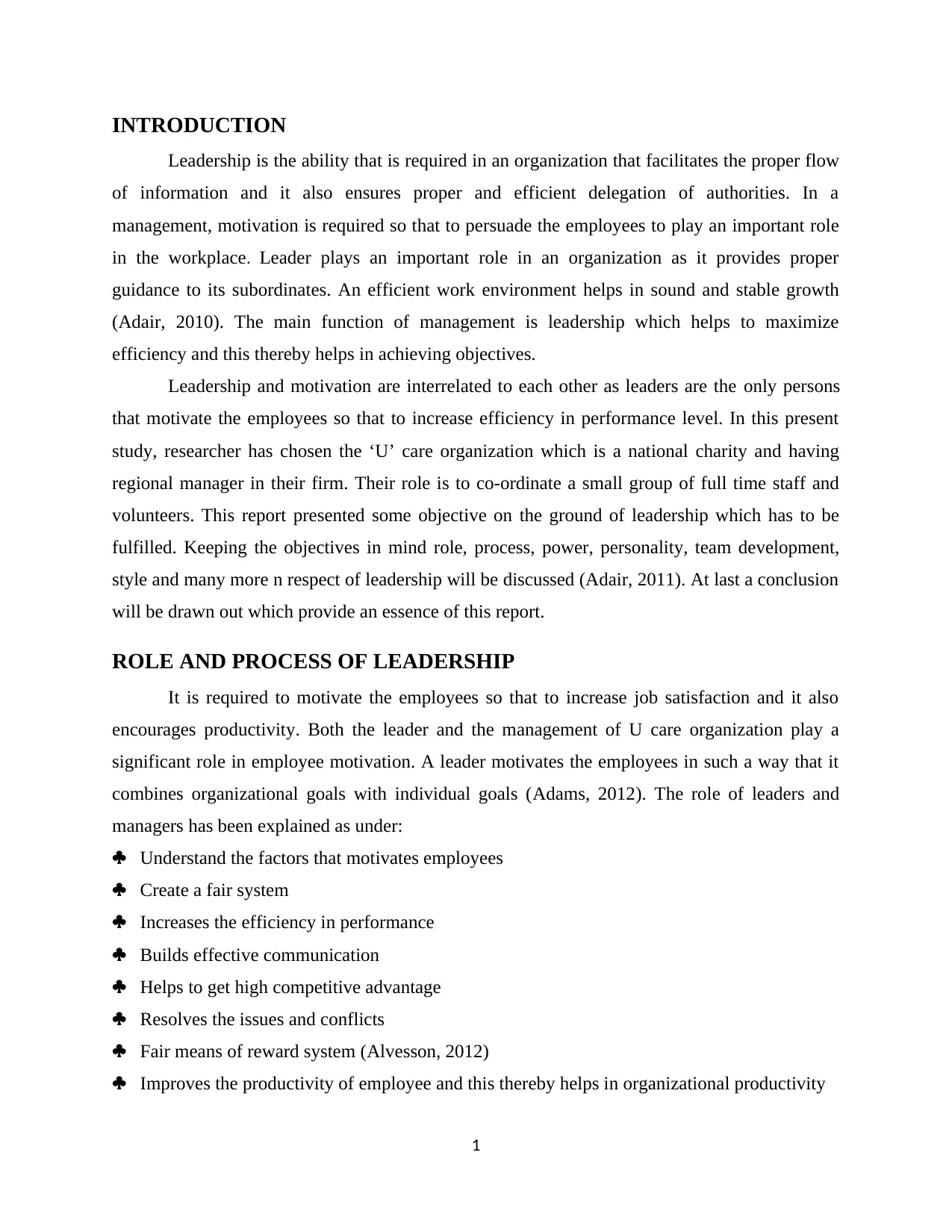
INTRODUCTION
Leadership is the ability that is required in an organization that facilitates the proper flow
of information and it also ensures proper and efficient delegation of authorities. In a
management, motivation is required so that to persuade the employees to play an important role
in the workplace. Leader plays an important role in an organization as it provides proper
guidance to its subordinates. An efficient work environment helps in sound and stable growth
(Adair, 2010). The main function of management is leadership which helps to maximize
efficiency and this thereby helps in achieving objectives.
Leadership and motivation are interrelated to each other as leaders are the only persons
that motivate the employees so that to increase efficiency in performance level. In this present
study, researcher has chosen the ‘U’ care organization which is a national charity and having
regional manager in their firm. Their role is to co-ordinate a small group of full time staff and
volunteers. This report presented some objective on the ground of leadership which has to be
fulfilled. Keeping the objectives in mind role, process, power, personality, team development,
style and many more n respect of leadership will be discussed (Adair, 2011). At last a conclusion
will be drawn out which provide an essence of this report.
ROLE AND PROCESS OF LEADERSHIP
It is required to motivate the employees so that to increase job satisfaction and it also
encourages productivity. Both the leader and the management of U care organization play a
significant role in employee motivation. A leader motivates the employees in such a way that it
combines organizational goals with individual goals (Adams, 2012). The role of leaders and
managers has been explained as under:
Understand the factors that motivates employees
Create a fair system
Increases the efficiency in performance
Builds effective communication
Helps to get high competitive advantage
Resolves the issues and conflicts
Fair means of reward system (Alvesson, 2012)
Improves the productivity of employee and this thereby helps in organizational productivity
1
Leadership is the ability that is required in an organization that facilitates the proper flow
of information and it also ensures proper and efficient delegation of authorities. In a
management, motivation is required so that to persuade the employees to play an important role
in the workplace. Leader plays an important role in an organization as it provides proper
guidance to its subordinates. An efficient work environment helps in sound and stable growth
(Adair, 2010). The main function of management is leadership which helps to maximize
efficiency and this thereby helps in achieving objectives.
Leadership and motivation are interrelated to each other as leaders are the only persons
that motivate the employees so that to increase efficiency in performance level. In this present
study, researcher has chosen the ‘U’ care organization which is a national charity and having
regional manager in their firm. Their role is to co-ordinate a small group of full time staff and
volunteers. This report presented some objective on the ground of leadership which has to be
fulfilled. Keeping the objectives in mind role, process, power, personality, team development,
style and many more n respect of leadership will be discussed (Adair, 2011). At last a conclusion
will be drawn out which provide an essence of this report.
ROLE AND PROCESS OF LEADERSHIP
It is required to motivate the employees so that to increase job satisfaction and it also
encourages productivity. Both the leader and the management of U care organization play a
significant role in employee motivation. A leader motivates the employees in such a way that it
combines organizational goals with individual goals (Adams, 2012). The role of leaders and
managers has been explained as under:
Understand the factors that motivates employees
Create a fair system
Increases the efficiency in performance
Builds effective communication
Helps to get high competitive advantage
Resolves the issues and conflicts
Fair means of reward system (Alvesson, 2012)
Improves the productivity of employee and this thereby helps in organizational productivity
1
Paraphrase This Document
Need a fresh take? Get an instant paraphrase of this document with our AI Paraphraser

Leadership is not an easy task to perform, Infect he/she is the representative of group or
organization. Their roles and responsibilities are so high. Roles that they follow are: leaders are
liable to manage the operations of team (Adair, 2010). In a group or team leader delegate
authorities to their member and work has to be done accordingly. Leader provides proper
guidance, supervision and cooperation to their team members if they find any problem in any
task. Last is leader deciding the fund that has been required to carry out the work means they
prepare the budget?
The above mentioned chart on leadership model displays four layers or steps in the team
leadership model. Those four steps are:
At the top layer, all members of a team perform and the organization evaluates the
performance of the team and determines the effectiveness of the team.
There is an internal and external analysis of the leadership level at the second stage.
2
Figure 1Hill's leadership model
(Source Bowerman, 2003)
organization. Their roles and responsibilities are so high. Roles that they follow are: leaders are
liable to manage the operations of team (Adair, 2010). In a group or team leader delegate
authorities to their member and work has to be done accordingly. Leader provides proper
guidance, supervision and cooperation to their team members if they find any problem in any
task. Last is leader deciding the fund that has been required to carry out the work means they
prepare the budget?
The above mentioned chart on leadership model displays four layers or steps in the team
leadership model. Those four steps are:
At the top layer, all members of a team perform and the organization evaluates the
performance of the team and determines the effectiveness of the team.
There is an internal and external analysis of the leadership level at the second stage.
2
Figure 1Hill's leadership model
(Source Bowerman, 2003)
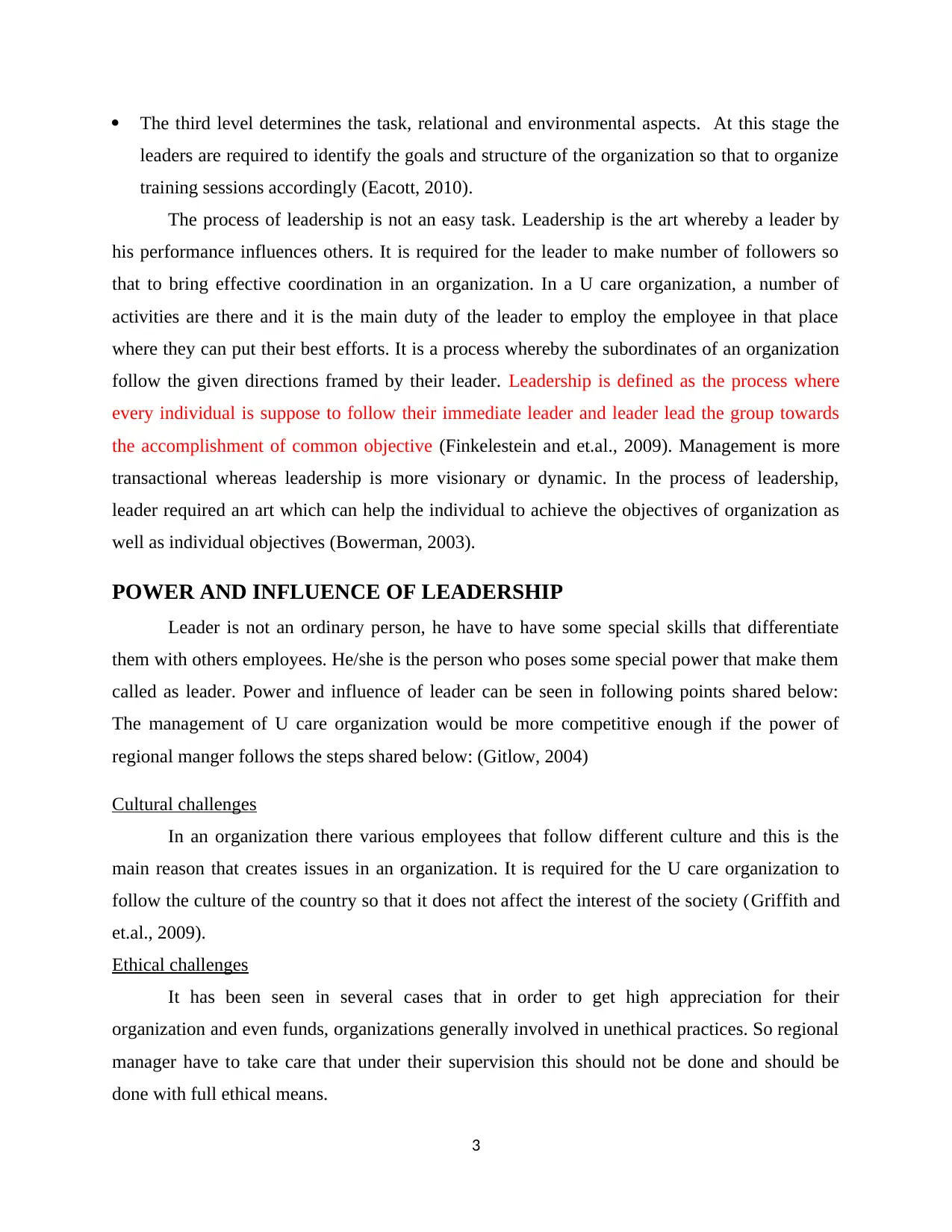
The third level determines the task, relational and environmental aspects. At this stage the
leaders are required to identify the goals and structure of the organization so that to organize
training sessions accordingly (Eacott, 2010).
The process of leadership is not an easy task. Leadership is the art whereby a leader by
his performance influences others. It is required for the leader to make number of followers so
that to bring effective coordination in an organization. In a U care organization, a number of
activities are there and it is the main duty of the leader to employ the employee in that place
where they can put their best efforts. It is a process whereby the subordinates of an organization
follow the given directions framed by their leader. Leadership is defined as the process where
every individual is suppose to follow their immediate leader and leader lead the group towards
the accomplishment of common objective (Finkelestein and et.al., 2009). Management is more
transactional whereas leadership is more visionary or dynamic. In the process of leadership,
leader required an art which can help the individual to achieve the objectives of organization as
well as individual objectives (Bowerman, 2003).
POWER AND INFLUENCE OF LEADERSHIP
Leader is not an ordinary person, he have to have some special skills that differentiate
them with others employees. He/she is the person who poses some special power that make them
called as leader. Power and influence of leader can be seen in following points shared below:
The management of U care organization would be more competitive enough if the power of
regional manger follows the steps shared below: (Gitlow, 2004)
Cultural challenges
In an organization there various employees that follow different culture and this is the
main reason that creates issues in an organization. It is required for the U care organization to
follow the culture of the country so that it does not affect the interest of the society (Griffith and
et.al., 2009).
Ethical challenges
It has been seen in several cases that in order to get high appreciation for their
organization and even funds, organizations generally involved in unethical practices. So regional
manager have to take care that under their supervision this should not be done and should be
done with full ethical means.
3
leaders are required to identify the goals and structure of the organization so that to organize
training sessions accordingly (Eacott, 2010).
The process of leadership is not an easy task. Leadership is the art whereby a leader by
his performance influences others. It is required for the leader to make number of followers so
that to bring effective coordination in an organization. In a U care organization, a number of
activities are there and it is the main duty of the leader to employ the employee in that place
where they can put their best efforts. It is a process whereby the subordinates of an organization
follow the given directions framed by their leader. Leadership is defined as the process where
every individual is suppose to follow their immediate leader and leader lead the group towards
the accomplishment of common objective (Finkelestein and et.al., 2009). Management is more
transactional whereas leadership is more visionary or dynamic. In the process of leadership,
leader required an art which can help the individual to achieve the objectives of organization as
well as individual objectives (Bowerman, 2003).
POWER AND INFLUENCE OF LEADERSHIP
Leader is not an ordinary person, he have to have some special skills that differentiate
them with others employees. He/she is the person who poses some special power that make them
called as leader. Power and influence of leader can be seen in following points shared below:
The management of U care organization would be more competitive enough if the power of
regional manger follows the steps shared below: (Gitlow, 2004)
Cultural challenges
In an organization there various employees that follow different culture and this is the
main reason that creates issues in an organization. It is required for the U care organization to
follow the culture of the country so that it does not affect the interest of the society (Griffith and
et.al., 2009).
Ethical challenges
It has been seen in several cases that in order to get high appreciation for their
organization and even funds, organizations generally involved in unethical practices. So regional
manager have to take care that under their supervision this should not be done and should be
done with full ethical means.
3
⊘ This is a preview!⊘
Do you want full access?
Subscribe today to unlock all pages.

Trusted by 1+ million students worldwide

Difficulty in decision making
In an organization, there are various employees and it is required for the management to
take opinions from its employees so that to get suitable advices (Finkelestein and et. al., 2009).
Hasty decisions leads to improper functions and this thereby affects the decision making ability.
Effectiveness is required so that to take correct decisions. Power and influence can be seen best
out there by molding the behavior of employees towards the common aim of organization and
further persuade them to become leader’s supportive role (Holt and et.al., 2003).
Gender issues
A lot many issues have been seen related to the gender biasness. Equal importance should
be given to all the employees so that to remove discrimination. But if the leader with ful
confidence educate their employees to not to raise such issues as they are equal for this
organization, then the regional manager can more effectively direct the operations and
performance of their volunteer and staff (Hughes and Beatty, 2011).
Improper training
There are many employees in a U care organization that requires training as medical
services cannot be granted without having proper knowledge (Finkelestein and et.al., 2009).
Leader can shoe their power to choose employees for training whose performance are not up to
the mark because carefulness in their work may dishearten the underprivileged young people.
Efficient training sessions are required so that to increase the efficiency of the employees and
this can help the organization to deliver better services (Kanter, 2004).
Time management
Time management is the essential task that requires efficiency. It is the main issue with
all the managers that they are not able to manage the activities. So in order to remove the issues,
they have to make best use of their power in assessing training regards to time management
(Hughes and Beatty, 2011).
Moreover, along with the above discussion power of leadership can also be defined
through this chart which explains the power of leadership at each level, they are as under:
4
In an organization, there are various employees and it is required for the management to
take opinions from its employees so that to get suitable advices (Finkelestein and et. al., 2009).
Hasty decisions leads to improper functions and this thereby affects the decision making ability.
Effectiveness is required so that to take correct decisions. Power and influence can be seen best
out there by molding the behavior of employees towards the common aim of organization and
further persuade them to become leader’s supportive role (Holt and et.al., 2003).
Gender issues
A lot many issues have been seen related to the gender biasness. Equal importance should
be given to all the employees so that to remove discrimination. But if the leader with ful
confidence educate their employees to not to raise such issues as they are equal for this
organization, then the regional manager can more effectively direct the operations and
performance of their volunteer and staff (Hughes and Beatty, 2011).
Improper training
There are many employees in a U care organization that requires training as medical
services cannot be granted without having proper knowledge (Finkelestein and et.al., 2009).
Leader can shoe their power to choose employees for training whose performance are not up to
the mark because carefulness in their work may dishearten the underprivileged young people.
Efficient training sessions are required so that to increase the efficiency of the employees and
this can help the organization to deliver better services (Kanter, 2004).
Time management
Time management is the essential task that requires efficiency. It is the main issue with
all the managers that they are not able to manage the activities. So in order to remove the issues,
they have to make best use of their power in assessing training regards to time management
(Hughes and Beatty, 2011).
Moreover, along with the above discussion power of leadership can also be defined
through this chart which explains the power of leadership at each level, they are as under:
4
Paraphrase This Document
Need a fresh take? Get an instant paraphrase of this document with our AI Paraphraser
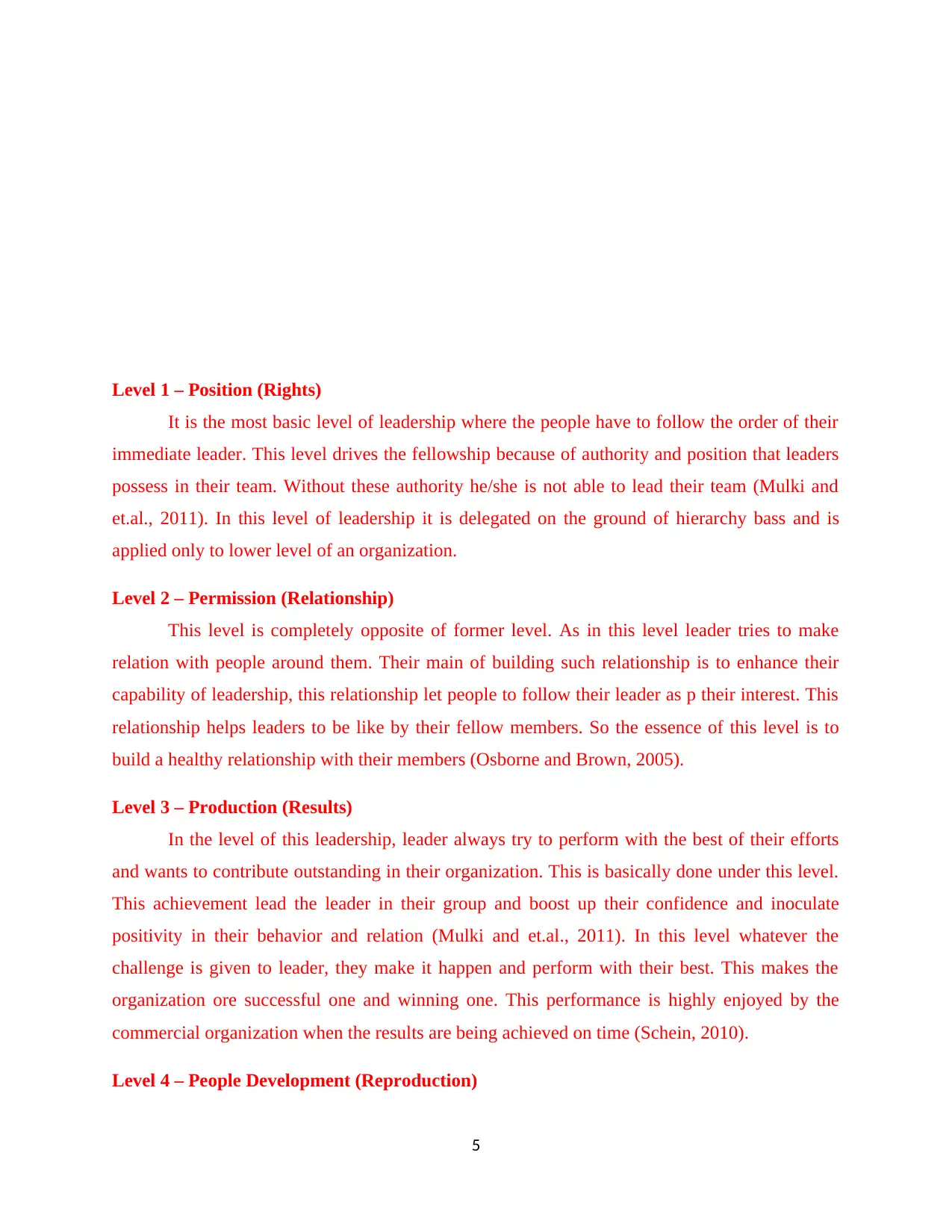
Level 1 – Position (Rights)
It is the most basic level of leadership where the people have to follow the order of their
immediate leader. This level drives the fellowship because of authority and position that leaders
possess in their team. Without these authority he/she is not able to lead their team (Mulki and
et.al., 2011). In this level of leadership it is delegated on the ground of hierarchy bass and is
applied only to lower level of an organization.
Level 2 – Permission (Relationship)
This level is completely opposite of former level. As in this level leader tries to make
relation with people around them. Their main of building such relationship is to enhance their
capability of leadership, this relationship let people to follow their leader as p their interest. This
relationship helps leaders to be like by their fellow members. So the essence of this level is to
build a healthy relationship with their members (Osborne and Brown, 2005).
Level 3 – Production (Results)
In the level of this leadership, leader always try to perform with the best of their efforts
and wants to contribute outstanding in their organization. This is basically done under this level.
This achievement lead the leader in their group and boost up their confidence and inoculate
positivity in their behavior and relation (Mulki and et.al., 2011). In this level whatever the
challenge is given to leader, they make it happen and perform with their best. This makes the
organization ore successful one and winning one. This performance is highly enjoyed by the
commercial organization when the results are being achieved on time (Schein, 2010).
Level 4 – People Development (Reproduction)
5
PersonhoodPeopleDeveloperProductionPermissionPosition
It is the most basic level of leadership where the people have to follow the order of their
immediate leader. This level drives the fellowship because of authority and position that leaders
possess in their team. Without these authority he/she is not able to lead their team (Mulki and
et.al., 2011). In this level of leadership it is delegated on the ground of hierarchy bass and is
applied only to lower level of an organization.
Level 2 – Permission (Relationship)
This level is completely opposite of former level. As in this level leader tries to make
relation with people around them. Their main of building such relationship is to enhance their
capability of leadership, this relationship let people to follow their leader as p their interest. This
relationship helps leaders to be like by their fellow members. So the essence of this level is to
build a healthy relationship with their members (Osborne and Brown, 2005).
Level 3 – Production (Results)
In the level of this leadership, leader always try to perform with the best of their efforts
and wants to contribute outstanding in their organization. This is basically done under this level.
This achievement lead the leader in their group and boost up their confidence and inoculate
positivity in their behavior and relation (Mulki and et.al., 2011). In this level whatever the
challenge is given to leader, they make it happen and perform with their best. This makes the
organization ore successful one and winning one. This performance is highly enjoyed by the
commercial organization when the results are being achieved on time (Schein, 2010).
Level 4 – People Development (Reproduction)
5
PersonhoodPeopleDeveloperProductionPermissionPosition
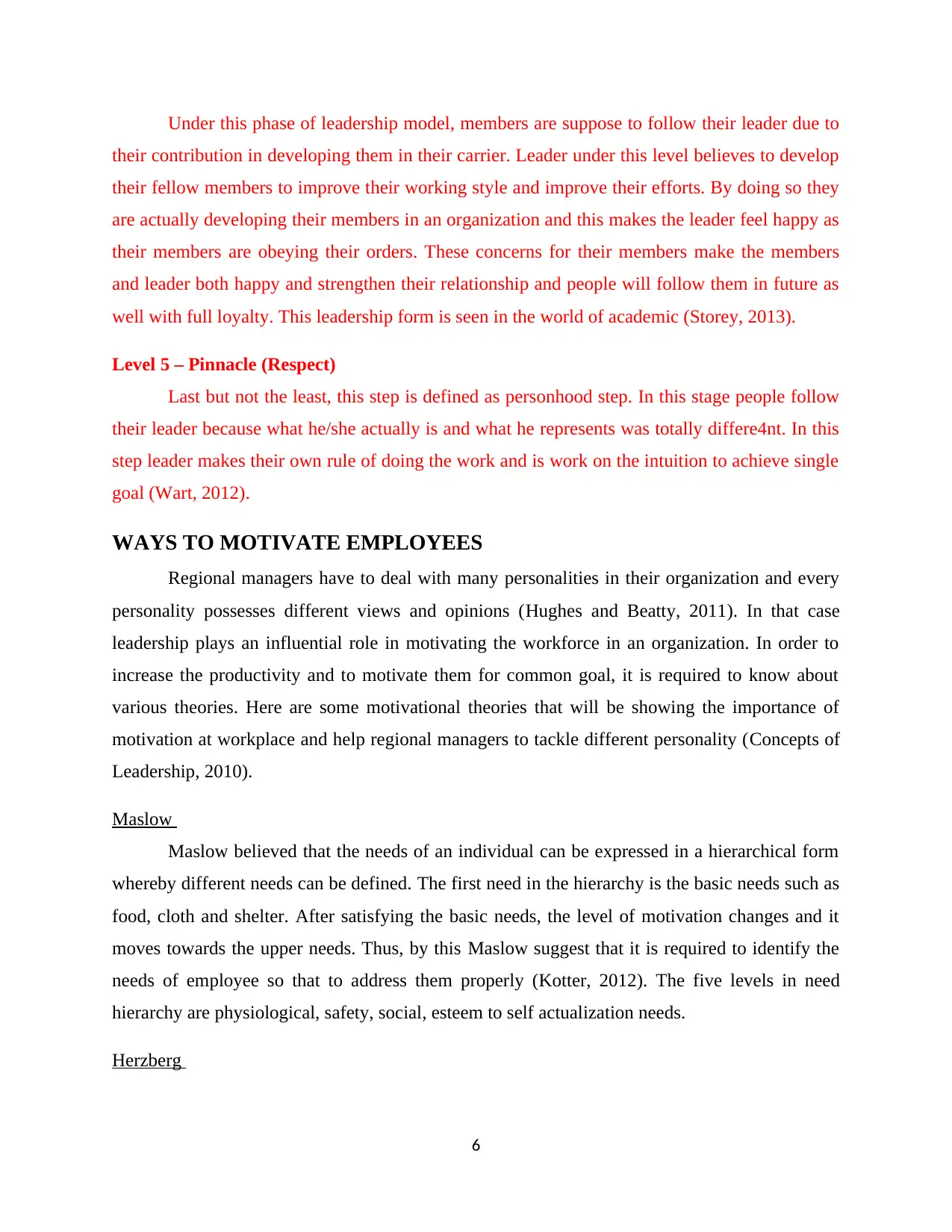
Under this phase of leadership model, members are suppose to follow their leader due to
their contribution in developing them in their carrier. Leader under this level believes to develop
their fellow members to improve their working style and improve their efforts. By doing so they
are actually developing their members in an organization and this makes the leader feel happy as
their members are obeying their orders. These concerns for their members make the members
and leader both happy and strengthen their relationship and people will follow them in future as
well with full loyalty. This leadership form is seen in the world of academic (Storey, 2013).
Level 5 – Pinnacle (Respect)
Last but not the least, this step is defined as personhood step. In this stage people follow
their leader because what he/she actually is and what he represents was totally differe4nt. In this
step leader makes their own rule of doing the work and is work on the intuition to achieve single
goal (Wart, 2012).
WAYS TO MOTIVATE EMPLOYEES
Regional managers have to deal with many personalities in their organization and every
personality possesses different views and opinions (Hughes and Beatty, 2011). In that case
leadership plays an influential role in motivating the workforce in an organization. In order to
increase the productivity and to motivate them for common goal, it is required to know about
various theories. Here are some motivational theories that will be showing the importance of
motivation at workplace and help regional managers to tackle different personality (Concepts of
Leadership, 2010).
Maslow
Maslow believed that the needs of an individual can be expressed in a hierarchical form
whereby different needs can be defined. The first need in the hierarchy is the basic needs such as
food, cloth and shelter. After satisfying the basic needs, the level of motivation changes and it
moves towards the upper needs. Thus, by this Maslow suggest that it is required to identify the
needs of employee so that to address them properly (Kotter, 2012). The five levels in need
hierarchy are physiological, safety, social, esteem to self actualization needs.
Herzberg
6
their contribution in developing them in their carrier. Leader under this level believes to develop
their fellow members to improve their working style and improve their efforts. By doing so they
are actually developing their members in an organization and this makes the leader feel happy as
their members are obeying their orders. These concerns for their members make the members
and leader both happy and strengthen their relationship and people will follow them in future as
well with full loyalty. This leadership form is seen in the world of academic (Storey, 2013).
Level 5 – Pinnacle (Respect)
Last but not the least, this step is defined as personhood step. In this stage people follow
their leader because what he/she actually is and what he represents was totally differe4nt. In this
step leader makes their own rule of doing the work and is work on the intuition to achieve single
goal (Wart, 2012).
WAYS TO MOTIVATE EMPLOYEES
Regional managers have to deal with many personalities in their organization and every
personality possesses different views and opinions (Hughes and Beatty, 2011). In that case
leadership plays an influential role in motivating the workforce in an organization. In order to
increase the productivity and to motivate them for common goal, it is required to know about
various theories. Here are some motivational theories that will be showing the importance of
motivation at workplace and help regional managers to tackle different personality (Concepts of
Leadership, 2010).
Maslow
Maslow believed that the needs of an individual can be expressed in a hierarchical form
whereby different needs can be defined. The first need in the hierarchy is the basic needs such as
food, cloth and shelter. After satisfying the basic needs, the level of motivation changes and it
moves towards the upper needs. Thus, by this Maslow suggest that it is required to identify the
needs of employee so that to address them properly (Kotter, 2012). The five levels in need
hierarchy are physiological, safety, social, esteem to self actualization needs.
Herzberg
6
⊘ This is a preview!⊘
Do you want full access?
Subscribe today to unlock all pages.

Trusted by 1+ million students worldwide

The theory is based upon those facts that lead disappointment. There are several factors
that demotivate the employees and the theory identifies the reasons that results in dissatisfaction
(Osborne and Brown, 2005). The main factors are concerned with the job of an employee. Other
elements are those that affect the work performance and motivation level. Motivation at this
stage is required so that to develop the growth aspects and also bring efficiency in work
performance (Leadership and Strategy, 2011).
7
that demotivate the employees and the theory identifies the reasons that results in dissatisfaction
(Osborne and Brown, 2005). The main factors are concerned with the job of an employee. Other
elements are those that affect the work performance and motivation level. Motivation at this
stage is required so that to develop the growth aspects and also bring efficiency in work
performance (Leadership and Strategy, 2011).
7
Paraphrase This Document
Need a fresh take? Get an instant paraphrase of this document with our AI Paraphraser
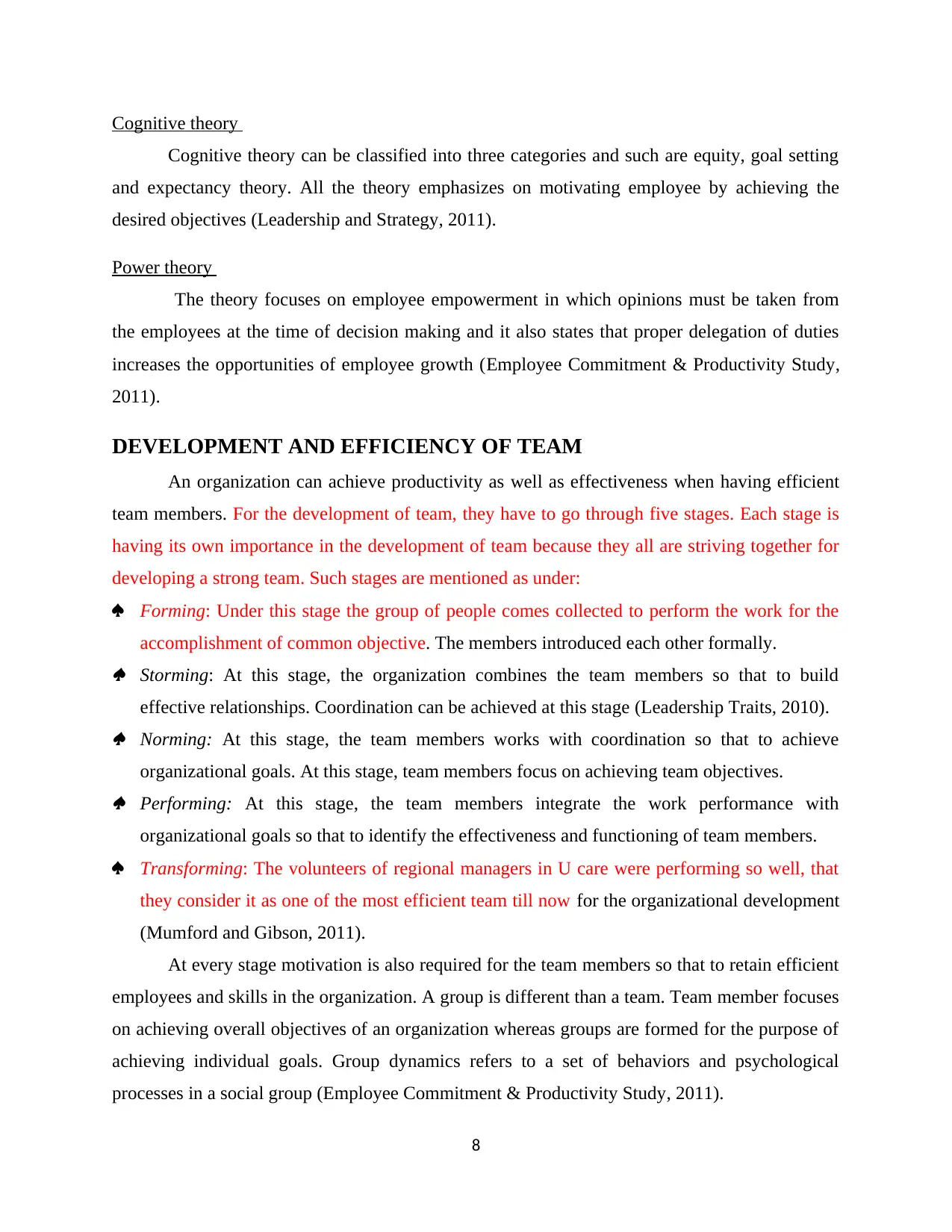
Cognitive theory
Cognitive theory can be classified into three categories and such are equity, goal setting
and expectancy theory. All the theory emphasizes on motivating employee by achieving the
desired objectives (Leadership and Strategy, 2011).
Power theory
The theory focuses on employee empowerment in which opinions must be taken from
the employees at the time of decision making and it also states that proper delegation of duties
increases the opportunities of employee growth (Employee Commitment & Productivity Study,
2011).
DEVELOPMENT AND EFFICIENCY OF TEAM
An organization can achieve productivity as well as effectiveness when having efficient
team members. For the development of team, they have to go through five stages. Each stage is
having its own importance in the development of team because they all are striving together for
developing a strong team. Such stages are mentioned as under:
Forming: Under this stage the group of people comes collected to perform the work for the
accomplishment of common objective. The members introduced each other formally. Storming: At this stage, the organization combines the team members so that to build
effective relationships. Coordination can be achieved at this stage (Leadership Traits, 2010). Norming: At this stage, the team members works with coordination so that to achieve
organizational goals. At this stage, team members focus on achieving team objectives. Performing: At this stage, the team members integrate the work performance with
organizational goals so that to identify the effectiveness and functioning of team members.
Transforming: The volunteers of regional managers in U care were performing so well, that
they consider it as one of the most efficient team till now for the organizational development
(Mumford and Gibson, 2011).
At every stage motivation is also required for the team members so that to retain efficient
employees and skills in the organization. A group is different than a team. Team member focuses
on achieving overall objectives of an organization whereas groups are formed for the purpose of
achieving individual goals. Group dynamics refers to a set of behaviors and psychological
processes in a social group (Employee Commitment & Productivity Study, 2011).
8
Cognitive theory can be classified into three categories and such are equity, goal setting
and expectancy theory. All the theory emphasizes on motivating employee by achieving the
desired objectives (Leadership and Strategy, 2011).
Power theory
The theory focuses on employee empowerment in which opinions must be taken from
the employees at the time of decision making and it also states that proper delegation of duties
increases the opportunities of employee growth (Employee Commitment & Productivity Study,
2011).
DEVELOPMENT AND EFFICIENCY OF TEAM
An organization can achieve productivity as well as effectiveness when having efficient
team members. For the development of team, they have to go through five stages. Each stage is
having its own importance in the development of team because they all are striving together for
developing a strong team. Such stages are mentioned as under:
Forming: Under this stage the group of people comes collected to perform the work for the
accomplishment of common objective. The members introduced each other formally. Storming: At this stage, the organization combines the team members so that to build
effective relationships. Coordination can be achieved at this stage (Leadership Traits, 2010). Norming: At this stage, the team members works with coordination so that to achieve
organizational goals. At this stage, team members focus on achieving team objectives. Performing: At this stage, the team members integrate the work performance with
organizational goals so that to identify the effectiveness and functioning of team members.
Transforming: The volunteers of regional managers in U care were performing so well, that
they consider it as one of the most efficient team till now for the organizational development
(Mumford and Gibson, 2011).
At every stage motivation is also required for the team members so that to retain efficient
employees and skills in the organization. A group is different than a team. Team member focuses
on achieving overall objectives of an organization whereas groups are formed for the purpose of
achieving individual goals. Group dynamics refers to a set of behaviors and psychological
processes in a social group (Employee Commitment & Productivity Study, 2011).
8

ORGANIZATIONAL CHANGE
Change is the rule of nature and no one can resist the change. In the same way, it is
applicable in organization as well where the management after a specific period of time brings
the change in the process to meet the new trends of working in a competitive world. This change
in an organization not only let the organization to match up with the new trend but also provides
them a opportunity to get a edge over their competitor and lead them all (Murphy, 2008). But it
is said that no organization can easily bring change in their organization. To cultivate this it they
need to first perform a in-depth research that what change in required and where it is required
and why it is required and what benefits they will get after the change. This all concepts has to be
cleared from the side of management so that they can communicate this to their employees in a
more specific and logical manner. Still people willed finitely result the change and this is can be
very drastic in nature. So to overcome such problem, in our case regional managers have held
responsible some volunteers which will be first educated about the change from the starting and
will be educated about the positive implication of the change in their U care, so that in future
they may not resist and can educate fresher’s in future that to how to bring the change and what
are the positive side of change (Schein, 2010). Regional managers can follow the Lewins model
of change which described as under:
Unfreeze Change Refreeze
Figure 2Lewins model
(Source: Nash and Hwang, 2012)
9
Change is the rule of nature and no one can resist the change. In the same way, it is
applicable in organization as well where the management after a specific period of time brings
the change in the process to meet the new trends of working in a competitive world. This change
in an organization not only let the organization to match up with the new trend but also provides
them a opportunity to get a edge over their competitor and lead them all (Murphy, 2008). But it
is said that no organization can easily bring change in their organization. To cultivate this it they
need to first perform a in-depth research that what change in required and where it is required
and why it is required and what benefits they will get after the change. This all concepts has to be
cleared from the side of management so that they can communicate this to their employees in a
more specific and logical manner. Still people willed finitely result the change and this is can be
very drastic in nature. So to overcome such problem, in our case regional managers have held
responsible some volunteers which will be first educated about the change from the starting and
will be educated about the positive implication of the change in their U care, so that in future
they may not resist and can educate fresher’s in future that to how to bring the change and what
are the positive side of change (Schein, 2010). Regional managers can follow the Lewins model
of change which described as under:
Unfreeze Change Refreeze
Figure 2Lewins model
(Source: Nash and Hwang, 2012)
9
⊘ This is a preview!⊘
Do you want full access?
Subscribe today to unlock all pages.

Trusted by 1+ million students worldwide
1 out of 19
Related Documents
Your All-in-One AI-Powered Toolkit for Academic Success.
+13062052269
info@desklib.com
Available 24*7 on WhatsApp / Email
![[object Object]](/_next/static/media/star-bottom.7253800d.svg)
Unlock your academic potential
Copyright © 2020–2025 A2Z Services. All Rights Reserved. Developed and managed by ZUCOL.




